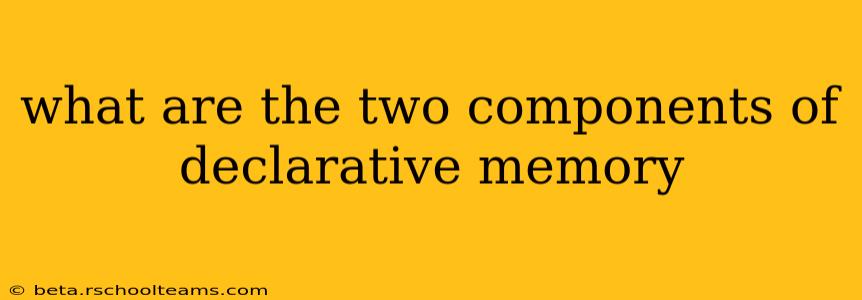What Are the Two Components of Declarative Memory?
Declarative memory, also known as explicit memory, is one of the two main types of long-term memory (the other being non-declarative or implicit memory). It's responsible for storing facts and events that you can consciously recall and declare. Crucially, declarative memory is further divided into two key components: episodic memory and semantic memory. Understanding the differences between these two is essential to grasping the full complexity of how we store and retrieve information.
1. Episodic Memory: Your Personal Timeline
Episodic memory refers to your personal experiences and events. Think of it as your brain's autobiographical record. It's the memory system that stores specific details about when and where something happened, along with the associated emotions and sensory information. For example:
- Remembering your first day of school: This isn't just knowing that you went to school; it's recalling the specific sights, sounds, smells, and feelings associated with that day.
- Recalling your last vacation: You remember not just that you went on vacation, but where you went, who you were with, and the specific events that unfolded.
- Remembering a significant birthday: This involves recalling the details surrounding the celebration, the people involved, and the emotions you experienced.
Episodic memories are tied to specific time and place contexts. They are personal and subjective, shaped by your individual perspective. The strength of an episodic memory often correlates with the emotional significance of the event.
2. Semantic Memory: The Encyclopedia of Your Mind
Semantic memory, on the other hand, stores general knowledge about the world. This is your internal encyclopedia, containing facts, concepts, and meanings independent of personal experiences. Examples include:
- Knowing that Paris is the capital of France: This is a fact you likely learned, not something you personally experienced.
- Understanding the concept of gravity: This is general knowledge about the world, not a specific memory of learning about gravity.
- Knowing the names of planets in our solar system: This is factual information stored in your semantic memory.
Semantic memories are not tied to specific time or place. They are shared knowledge, largely independent of personal experience. While you might remember learning about the planets, the knowledge itself resides in semantic memory.
The Interplay Between Episodic and Semantic Memory
While distinct, episodic and semantic memory aren't entirely separate. They often interact and influence each other. For example, your episodic memory of a history lesson might contribute to your semantic knowledge of historical events. Similarly, pre-existing semantic knowledge can aid in encoding and retrieving episodic memories. A strong understanding of historical context (semantic) will help you better remember the details of a historical documentary (episodic).
Understanding the distinction between episodic and semantic memory is crucial in fields like cognitive psychology, neuroscience, and even artificial intelligence, as it helps us better understand how the human brain processes and stores information. It also has implications for how we learn, remember, and retrieve information effectively.
